
At a distance of 384400 km, which is barely one unit on an astronomical scale, the moon, Earth’s only natural satellite, is its closest celestial object. Due to this proximity, and with the help of technology, it is the first celestial body outside our own planet on which mankind has been able to set foot on. As the ‘First Man’ said as he took his first steps on the moon, and as humanity watched in awe on July 20, 1969, “One small step, one giant leap for mankind”, the same goes for our ambitions of becoming a space-faring civilization.

Setting up a colony on the moon sounds promising and exciting, but the important thing is that it needs to be self-sustaining. For example, through mining and refining of minerals which can benefit people both on the Earth and the Moon. Space-based materials processing has some very interesting advantages. For instance, in the process of manufacturing “foaming materials” on Earth, where gas is injected into molten metal, bubbles rise and burst. But, in microgravity environments, these complications do not exist. Another example is in the process of annealing, where the material is kept heated for an extended period of time to allow specific textures to develop. These can be conducted more effectively in space as the only mode of energy loss during the process is through radiation.
He-3 or Helium 3, which will have an indispensable role as a fuel in thermonuclear fusion reactors, may be present in the lunar regolith in concentrations of 0.01–0.05 ppm, as a result of accumulating on the moon’s surface over billions of years owing to concentration by the solar winds. Scientists are now convinced that the lunar surface supports water that is not only locked up within mineral structures but also scattered throughout the broken-up lunar surface, potentially as ice. It is estimated there is at least 600 million tons of pure ice at the lunar north pole, at least a couple of meters thick.

China builds an “artificial moon” that simulates low gravity conditions
With such huge potential and resources present in abundance, it is not much of a surprise that humanity is constantly thinking of making the Earth’s satellite a second home. But with a hostile environment without a habitable atmosphere, unprotected from blasts of ultraviolet radiation from the sun, and 1/6th of the gravity we are used to, it would definitely be a bit of an overstretch if we said we will be spending our next summer on the moon. China, however, disagrees with that.
Chinese scientists have been able to build a research facility that is capable of simulating low gravity environments or even making gravity disappear. This simulator which is also being nicknamed “the Artificial Moon”, is located in the eastern city of Xuzhou in the Jiangsu province of China.
Principle
The facility, slated for the official launch this year, will use powerful magnetic fields inside a vacuum chamber of 2-foot-diameter or 60 centimeters to make gravity “disappear”. It is said that the scientists were inspired by an earlier experiment that used magnets to levitate a frog. Now if you are wondering whether this amphibious gentleman in question was Magneto, then sorry to disappoint you, but no. The particular ‘floating frog experiment’ from which the researchers drew their inspiration was conducted by Andre Geim, a Russian-born physicist at the University of Manchester, U.K. He used the concept of diamagnetism — when a material is exposed to a magnetic field orbiting electrons in the material modify their motion to produce a magnetic field that opposes the external one, thus trying to minimize it. When these two magnetic fields, the external as well as the internal (caused by the orbiting electrons) become equal, they effectively cancel out each other and thus the material seems to levitate in the magnetic field. Organic materials like living cells are very weakly diamagnetic and hence, when a very strong magnet (chiefly used for crystallographic experiments) is employed, the living object levitates. In fact, it took nearly 16 Teslas to lift the confused amphibian off the ground. Andre Geim received the satirical IG Nobel prize for his ground-breaking work. This particular levitation trick used by Geim and now used in the artificial moon chamber comes from an effect known as ‘diamagnetic levitation.
Li Ruilin, a geotechnical engineer at the China University of Mining and Technology, confirmed that the chamber will be filled with rocks and dust as light as those on the moon to simulate its conditions. He said that this simulator is the “first of its kind in the world” and is capable of maintaining such low gravity conditions as long as required.
 China builds an “artificial moon” that simulates low gravity conditions
China builds an “artificial moon” that simulates low gravity conditions
China Has Built An Artificial Moon Facility To Simulate Lunar Conditions On Earth
Applications
There are innumerable applications of this astounding piece of technology. Scientists plan to now test their technology in prolonged microgravity environments before sending them to the moon where gravity is just one-sixth of that of the Earth. This will allow them to iron out any costly technical kinks, as well as to test whether certain structures will survive on the moon’s surface and assess the viability of a human settlement there. According to Li Ruilin, the geotechnical engineer at the China University of Mining and Technology, some experiments can take just a few seconds in the simulator while others such as creep testing can take several days. A creep test determines and measures how much a material will deform under stress at a constant temperature. The simulations can also provide crucial information about whether 3-D structures can be constructed on the moon’s surface. Furthermore, it can provide some important clues as to where to find water trapped under the moon’s surface. However, as of now, astronauts cannot be trained in this simulator owing to its rather small size. However, once it is upgraded and technology is able to make the environment larger, opportunities of testing various technologies, such as performing test drilling in simulated lunar conditions, training of astronauts etc., can have innumerable benefits before they are shipped off to the stars.
Conclusions
According to the scientists, the newly built facility will augment China’s ongoing Lunar program, and will be routinely used to test instruments before they are sent to the moon. The tests completed in the chamber will be used to inform China’s Lunar Exploration Program Chang’e, which derives its name from the Chinese goddess of the moon. This initiative includes Chang’e 4, which landed a rover on the far side of the moon in 2019, and Chang’e 5, which retrieved rock samples from the moon’s surface in 2020. China has also declared that it will establish a lunar research station on the moon’s south pole by 2029.
All this sounds really encouraging and exciting. This is how we humans advance — we observe, we experiment, and then we try to determine the best possible way of using our understanding. Such facilities which are capable of simulating low gravity environments for prolonged periods of time are perhaps a preliminary indication that we humans are on our way to become an interplanetary species. Our curiosity has already brought us this far. It is not an easy feat to predict where we might end up. That responsibility is ultimately ours, if we avoid mass genocide and avoid stupidity, our future may not be bleak…. Who knows, perhaps we might find some new, interstellar friends!





